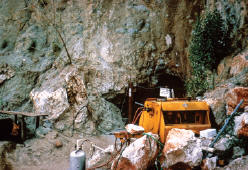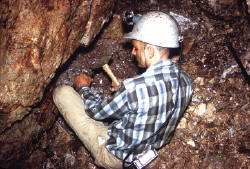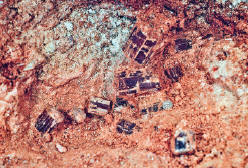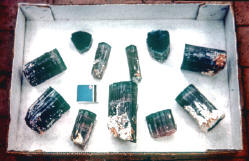Quartz was very common in thepockets and was frequently well formed. Usually it was colorless, milky or lightcitrine. The size of some crystals associatedwith tourmalines
reached over 20cm. The majority of the most famousspecimens from the mine are a combinationof quartz crystals and tourmalines.

Mine portal in 1972. J. Scripps photo.

Resting at the front of the mine in 1972. J. Scripps photo.
Tourmaline was the main goal ofmining in the beginning of the 20th centuryand later, during the collectors'specimen-focused operations. It was alsothe species that made the
mine famous.
Analytic works showed that tourmalinesfrom the Tourmaline Queen Mine are elbaites.
They form prismatic crystals,more or less elongated, with the trigonalprism and pedion typical for the species.
More complex terminations occurred onsome of the smaller specimens. The pedionface was frequently matte, but insome cases, like in the “blue-cap” pocket,it was mirror
lustrous. Prism faces werealways heavily striated. Split growth wasfrequently present on the larger crystals.
It was manifested by the growth ofsmaller individuals that were almost parallel to the main crystal. Thesize of the crystals variedreaching in some cases over 20cm for gem
crystals! Most of the crystals were a few cm long. The mostunique characteristic for the mine wasthe hot pink to almost red rubelite color.
It was often associated with all theshades of blue, from grayish to deepblue. The core of the crystals was usuallypink, while the last phase of growthwas blue. Probably Mn
enrichment wasresponsable for the pink color and Fe forthe blue one. Pure indicolite crystals arealso known. Multiple color crystals werealso found in some pockets. In suchcases the color changed from green andpurple to pink and blue within the samecrystal.
MINING HISTORY AND MOST IMPORTANTPOCKETS AND SPECIMENSThe end of the 19th century and thebeginning of the 20th was theperiod of quickly growinggem research andmining industry inSouthern California.
Intense pink rubelites,which weresent to China forcarving as gemstonesand latersold to several UScompanies includingTiffany & Company,were especiallyvaluable at that time.
In 1903 FrankSalmons (a store owner inPala) and C.W. Ernsting(jeweler), initiated a partnershipfor mining and selling gemstones. Their main goal was to finda new source of tourmalines to supplythe growing demand. At the same timeSalmons, together with John Giddens,hired two Basque sheep herders tocarry out the research in the nearbymountains. They quickly found the gemtourmalines and pegmatite vein nearthe top of the hill today known as TourmalineQueen Mountain. In a shorttime they collected quite a lot of gem material.
When they came back the fourof them decided to claim the areatogether. They did so on November 6,1903 naming the claim the TourmalineQueen.
From the descriptiongiven by GeorgeKunz, who relied on the1904 Waldemar Schaller report,we know that at the timethere was already an open cut, 3 meters deep and20 meters long, and thatabout 35 kg of gem tourmalines had beenrecovered. He reported yellow, green,pink and ruby red crystals.
Shortly thereafter, the TourmalineQueen Mine became one of the biggestproducers of gem tourmalines in SouthernCalifornia (along with the HimalayaMine). The most productive period wasbetween 1904 and 1914. During this periodextended surficial and undergroundmining was done and an undergroundtunnel almost 300 meters long wasdriven. It remains unknown how muchtourmaline was produced in that period,but we know that the sale of tourmalinewas about $50,000 only in one year –1913. There were numerous pockets withgem crystals found in 1904-1914 andhundreds, if not over a thousand, kilogramsof gem tourmaline were mined.
Almost all the material was cut andcarved, hence almost no specimens fromthat period have survived. What is interestingis that the carvings made in Chinafrom the California
material are nowvery highly sought by US collectors aspieces of the history of the TourmalineQueen Mine. One of very few specimensthat survived from the mentioned periodwas
collected in 1913. It is the so called“Postage Stamp Tourmaline” which consistsof a 7 cm long single tourmaline andtwo quartzes. It was pictured on the 10cent American postage
stamp printed in1974 in the Mineral Heritage series.
The revolution in China that tookplace at the turn of 1911/1912 was importantto the history of the mine, whichmight seem surprising. The Emperor ofChina abdicated and the
socialists cameto power. The aristocracy was in retreatand the Chinese market for luxurycarved gemstones rapidly collapsed. Almostat the same time (1913) the localgemstone market in the USA collapsed,resulting in the closing of the majority ofthe mines in Southern California, including the Tourmaline Queen Mine, in 1914.

Bob Bartsch collecting in the mine in 1972.R. Currier photo.

Tourmaline crystals in situ in the pocket clay. J. Scripps photo.

Flat with freshly mined “blue-cap” tourmaline crystals. J. Scripps photo.








 YueGongAnBei 44051102000467
YueGongAnBei 44051102000467


 |
|